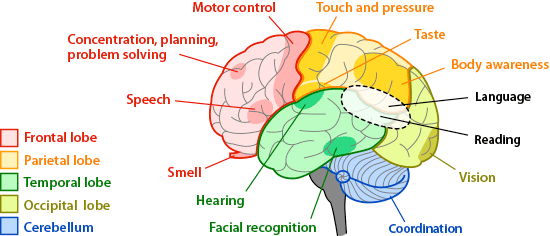
Creating a vivid and memorable scene is something that writers, myself included, strive for. I’ve been fortunate enough to have readers comment to me that my stories feel ‘cinematic’ to them, as though they were in the scene watching it. Of course, as with anything involving writing, an individual writer’s style can vary from the non-immersive (tons of was – e.g. “there was a” all over the place) to over-description where each piece of furniture in a room gets its own paragraph. (Which is perhaps even worse than no description at all.)
Many writers make extensive use of visual and auditory descriptions as they leap to the forefront of the mind. The human brain is a funny thing. There are three more senses a writer can invoke to bring the reader deeper into the scene – touch, taste, and smell.

Image courtesy of https://askabiologist.asu.edu/what-your-brain-doing
For many people, the sense of smell is a trigger for vivid memories, yet many writers tend to overlook it. When your character is going down rickety wooden stairs to a damp, basement – consider adding a description of how it smells down there. What does the air taste like on the character’s tongue? How does the railing feel under their hand? A few well-placed tiny bits of description can far outweigh a ‘wall-of-text’ of what the basement looks like.

People tend to attach smells to powerful memories. An elderly person catching a whiff of some food their mother used to make them as a child can take them right back to that moment. A combat veteran who survived an IED that hit his truck smells burning diesel and the horrors of the battlefield paralyze him with grief over the friends he lost a decade later.
Here is an excerpt from Division Zero: Thrall (Book 3). Kirsten, even ten years after the scene below, still can’t tolerate the smell of beef stew laced with the hint of chemical.
She jumped at the touch, fearing the kind of hand Mother would lay upon her. His was different, warm, comforting. The man’s voice fell away to the warble of indistinct remembrance as he said comforting things and kept petting her hair like a cat. Kirsten stared at the metal octagon in her hands, salivating at the promise of untainted food. She listened to his thoughts; he would not harm her―she was precious.
The crack of the lid, yielding to a grimy little finger, startled her awake amid the remembered hiss of the chemical warming agent and the smell of beef stew.
Sometimes the use of smell can be small – a few words – to add more depth to a scene (excerpt also from Thrall):
She wobbled back, rubbing her leg. “Damn, tough doors.” Out came the E-90. “You have two seconds to open this door or I’m opening it for you.”
One laser blast melted the retaining bar and flooded the air with the glue-plastic stink of molten Epoxil. The door swayed ajar. Kirsten raised her boot to kick it, but dove sideways at the sound of a gunshot. A bulge in the door showed where the dense material trapped the slug. Rolling onto her back, she aimed through her knees. Another shot―no bulge.
Feel
Another often underutilized descriptive tool is the sense of touch. There are thousands of ways to use touch to add to a scene depending on the mood of the piece. In a tense scene where a character is creeping through an unknown place, consider a trail of sweat tickling down under their clothes. Another character has to cross a small creek – and her sneakers get waterlogged. For the rest of that chapter, she’s walking in squidge. Almost everyone can relate to being stuck in soaked shoes, and how miserable that is… especially when its cold out.
This excerpt is from Prophet of the Badlands, illustrating the use of ‘touch’ as a sense.
At the bottom, she dropped thigh deep into water frigid enough to paralyze her. Althea clamped her hands over her mouth and swallowed a shriek, fearful of attracting attention. Seconds later, she sucked in a breath through chattering teeth and forced herself to move. Ripples spread from her legs as she walked, jostling the floating junk. Her natural reaction to such cold water kept her motion slow enough not to make noise. A layer of clammy slime squished through her toes as it gave way to the coarse texture of old concrete below. Althea advanced without hesitation, pushing the flotsam aside; she had stepped in worse things than this before.

In short, remember to involve your reader’s senses―all five of them. Drop a line here and there about what a scene smells like, even two words about a character’s cologne or the overpowering smell of wood varnish in the air can ramp up the immersion factor of a scene. Maybe if you get lucky, a reader will catch a smell in the air long after reading your work – and remember it.


